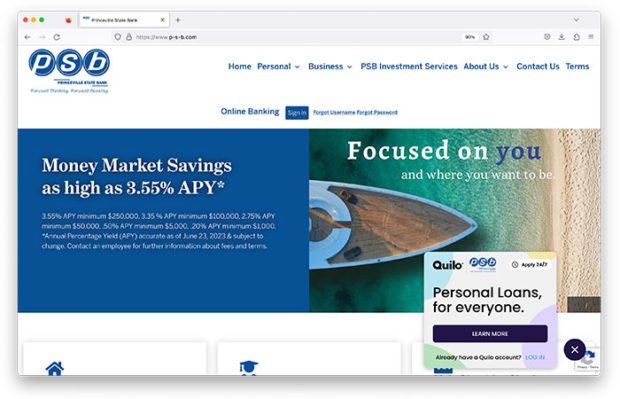For most banks, a $500 personal loan is a thing of the past. But at Princeville State Bank in rural Illinois, customers were still coming in to apply for small, unsecured loans — a process that chewed up about 90 minutes for loan officers tasked with taking the applications.
Princeville State didn’t want to abandon the business. However, it wanted a faster, tech-oriented solution, “something that shows that we’re a little bit more cutting-edge, that we’re not just the old, rural, farm-town bank that has a cool design on their checks,” says Andrew Black, president and chief executive of the $109 million-asset institution in Princeville, Ill., north of Peoria.
The answer arrived via the ThinkTECH Accelerator, a program started by the Independent Community Bankers Association to match community banks with early-stage fintechs. During the accelerator’s 2022 edition, Princeville State struck up a relationship with Quilo, which had developed a digital application platform for unsecured loans.

Andrew Black, Princeville State Bank
After testing the product in-house, the bank rolled out Quilo to its customers in fall 2022, Black says. It makes the loans directly to its retail banking customers and through small businesses that want to offer point-of-sale financing to their customers.
“I think it’s awesome,” Black says.
Fintechs like Quilo are helping banks get back into the business of unsecured small-dollar lending. Many had abandoned these loans because the time and effort involved in processing the applications often made them unprofitable.
The technology makes unsecured lending more efficient — and helps banks like Princeville State retain customers that might otherwise look elsewhere for loans.

Are You Ready for a Digital Transformation?
Unlock the potential of your financial institution's digital future with Arriba Advisors. Chart a course for growth, value and superior customer experiences.

The Power of Localized Marketing in Financial Services
Learn how to enhance your brand’s local visibility, generate more leads, and attract more customers, all while adhering to industry regulations and compliance.
Read More about The Power of Localized Marketing in Financial Services
Can Community Banks Compete in Point-of-Sale Financing?
There is plenty of competition in unsecured lending these days. AfterPay, Affirm and Klarna are among the fintechs partnering directly with retailers to offer financing in the form of “buy now, pay later” plans at the point of sale. Other fintechs also work with contractors and health care providers to allow them to offer installment loans to their customers.
According to a 2021 analysis by the consulting firm McKinsey & Co., fintechs active in unsecured lending at the point of sale have vacuumed up between $8 billion and $10 billion in annual revenue that might have gone to banks otherwise. Banks that underestimate the threat could continue to lose market share, especially among younger borrowers, McKinsey warned.
A Big Chunk of Change:
The amount of revenue banks lose each year to fintechs that are active in unsecured lending at the point of sale:$8-10 billion
Is there room in the market for community banks, at least for longer-term installment loans? Potentially, says Udai Kaura, a partner at McKinsey. “It will depend from community bank to community bank if they have enough scale in the markets they operate in. I believe it could be a growth lever that they could explore.”
Banks have several options to participate in personal lending, he says. They could fund lenders already active in it, forgoing the consumer relationship but earning something from the loans. They could also work with outside vendors to provide a white-label solution offered under their own name. But banks would then face the challenge of creating a distribution network.
“That can be challenging for a community bank that doesn’t have the sales force to actually go build that,” says Kaura, noting that national players have spent heavily on the distribution side.
The Instant Financing Boom: ‘It’s Going to Be Everywhere’
Don Shafer, co-founder and chief evangelist of Quilo, believes banks can’t afford to overlook instant financing. Every business that can offer this payment option is likely to be doing so within a year, he says, citing the push by vendors to sign up all types of merchants.
“It’s not everywhere yet, but it’s going to be everywhere,” says Shafer.
Quilo, based in Kalispell, Mont., focuses solely on banks and credit unions as its customers. They, in turn, make the lending platform available to the consumers and businesses that they serve.
Shafer, who was involved in the launch of Kasasa, co-founded Quilo with Boris Fuzayloff, who brought experience working on fintech solutions for large banks. They began marketing the platform in early 2022, and First Community Bank and Trust, a $191 million-asset institution in Beecher, Ill., was the first to sign up, says Shafer. The fintech has more than 50 bank and credit union clients now.
Quilo pulls credit information to underwrite every loan and, depending on the amount, also verifies a borrower’s income.
For a bank’s customer, it typically takes about three minutes to apply and secure loan approval, Shafer says. For a noncustomer, it takes about eight minutes.
Quilo tweaked its business model early on after a customer at one bank ultimately got a home-improvement loan somewhere else, Shafer says. The bank had set a loan cap of $15,000 but the customer needed more.
Caps on unsecured loans are common at small banks, Shafer says. So, the Quilo team pivoted to build a syndication option on its platform. A bank now can originate an unsecured loan and farm out portions it is not willing to carry on its own books to other community banks.
“It’s a huge deal, because every community bank in the country can now start offering loans up to $60,000 unsecured, knowing they’re not going to increase their financial risk,” Shafer says.
It’s also helpful to the banks that share in those loans, he says. Some might have deposits they need to put to work, while others may lack loan opportunities in their local markets.
Quilo — which does all of the loan servicing — charges a one-time origination fee based on the size of the loan. It is less than 1%, Shafer says. Banks typically absorb the fee, he adds.
Read more: 5 Fintech Strategies That Banks Should Adopt

An Edge Over Fintechs, Thanks to the Trust Factor
As Shafer sees it, community banks have an edge over fintech competitors that are pursuing consumers directly.
To drum up business, the banks can draw on their existing relationships with individuals and businesses, Shafer says. “People would love to know, ‘I’m getting a loan from my local bank, not some company I never heard of,'” he says.
And, he says, Quilo has made it easy for banks to extend this service to local businesses. Using the fintech’s platform, banks can create unique QR codes for participating businesses to print on cards they hand to consumers interested in instant financing.
Quilo’s platform also enables banks to launch email campaigns to individual customers centered around holidays or other events, Shafer says.
“People would love to know, ‘I’m getting a loan from my local bank, not some company I never heard of.'”
— Don Schafer, Quilo
During the ICBA accelerator program, the Quilo team learned it needed to keep things simple and easy-to-use for consumers. This feedback led Quilo to make it possible for banks to offer the loans through their own websites.
So there is no separate Quilo app, Shafer says. “That was huge. And that was because of what they told us.”
Borrowers typically have a separate log-in for their Quilo loan, he adds, though lenders could choose to integrate this into their online banking using the fintech’s application programming interfaces, or APIs.
Read more: How to Get the Best Results from Fintech Partnerships

What a Digital Personal Loan Can — and Can’t — Do
Alex Johnson, an analyst who writes the “Fintech Takes” newsletter, says he can see why Quilo would be interesting to community banks and credit unions, though, in the bigger picture, it is “probably not a game changer.”
He says smaller financial institutions have two competitive challenges: manufacturing and distribution.
“This product helps with manufacturing — quickly creating a digital personal loan product that meets the expectations of consumers,” Johnson says. “That’s useful, given that community banks and credit unions don’t have a ton of resources to throw at product development.”
But, similar to McKinsey’s Kaura, he notes that distribution remains an issue. Big banks and fintech lenders are going after everyone, including the customers of smaller institutions, he says. Embedded finance allows even merchants to offer loans to the customers of these institutions.
“It doesn’t appear that this product is focused on solving that distribution challenge, but I do think that’s the big problem for community banks and credit unions moving forward,” Johnson says.
See all of our most recent coverage of fintechs.

Navigating the Role of AI in Financial Institutions
83% of FI leaders agree investing in AI is essential for 2024 but how you leverage AI is instrumental in success and meeting customer expectations.
Read More about Navigating the Role of AI in Financial Institutions

Unlocking Digital Acquisition: A Bank’s Journey to Become Digital-First
This webinar will offer a comprehensive roadmap for digital marketing success, from building foundational capabilities and structures and forging strategic partnerships, to assembling the right team.
Read More about Unlocking Digital Acquisition: A Bank’s Journey to Become Digital-First
Quilo Frees Up Bank Employees to Focus on Bigger Loans
Princeville State Bank began lending on the Quilo platform in early fall 2022, Black says. It has set a cap of $15,000 on the loans but will syndicate loans above that level for customers who want to borrow more.
Its customers access Quilo via the bank’s website. But when they click to apply, this launches Quilo’s application, which is co-branded with Princeville State.
The bank has not yet taken part in any Quilo loans syndicated by other financial institutions, preferring to focus on lending first, Black says.
He did not have figures for its total lending on the Quilo platform so far, though he expects that the bank’s volume of unsecured personal loans is up from the period prior to its partnership with the fintech. “We just need to do a better job of marketing,” he says.
A bigger benefit for Princeville State is in efficiency: Staff members who would have been tied up with underwriting loans for as little as $500 can now shift their attention to larger commercial and industrial transactions, Black says. “They’re spending that time maybe doing credit analytics on a $750,000 loan, assisting our senior lender, and jumping into some bigger and better things.”








